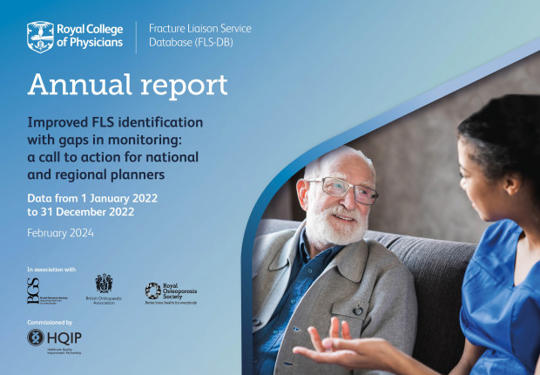The seventh annual report for the Fracture Liaison Service Database (FLS-DB), 'Rebuilding FLSs to meet local patient need', provides national benchmark performance for the care of people with fragility fractures in 2022.
The Fracture Liaison Service Database (FLS-DB) collects, measures and reports on the care provided by FLSs. Since it began in January 2016, nearly 500,000 patient records have been entered by FLSs across the NHS in England, Wales and Northern Ireland. This annual report presents the results of secondary fracture prevention care received by over 65,000 patients aged 50 and older following a fragility fracture between January and December 2022 from 69 FLSs.
This report describes the assessment and treatment of osteoporosis by 69 FLSs for 65,843 patients who sustained a fragility fracture in 2022, for use by healthcare professionals, decision-makers and the wider NHS.
Nationally, between 2021 and 2022, despite the significant pressures on the NHS, there was a major improvement in identification of patients and falls assessment. This is to be applauded, but there was little improvement in time to DXA or monitoring. The reporting also found there has been no improvement in assessment or monitoring, and inequity is demonstrable with poor FLS governance.
Local commissioners and FLSs should use this report to improve the effectiveness in post-fracture care delivery from existing FLSs through service improvement and additional commissioning to reduce the number of preventable fragility fractures in this high-risk patient group. A webinar was hosted in 2024 to discuss the findings of the report.
If your organisation (hospital, primary care practice, network and/or other community service) treats fractures you need to participate in the FLS-DB.
- More FLSs are now delivering over 80% identification rates for non-spine fractures. FLS that have prioritised improvement in KPI 2 and 3 should contact these services to share best practice for funding and identification pathways.
- To meet the healthcare recovery targets from the pandemic, FLS funding should be prioritised based on expected number of avoided fractures from a comprehensive service. FLSs should describe their capacity gaps and the expected benefit vs effort from re-organising pathways to ensure that at least 80% of higher risk patients are checked within 16 weeks of their fracture.
- FLSs should work with their local DXA providers to ensure access to DXA is based on patient need. This may require FRAX before DXA pathways, increasing follow up based on evidence and using FRAX only recommendations to clear backlogs of patients that are unlikely to be cleared in the next 4 months.
- FLS care pathways should acknowledge that specific patient groups need a personalised approach to assessment, decision-making and support. This includes providing patient-facing materials that reflect the languages of their local population.
- All senior executive decision-makers should hold a key stakeholder meeting to explore how local needs for fragility fracture patients can be met. Patient representatives and members of the Royal Osteoporosis Society should be invited to the meeting, and it should plan for effective and sustainably resourced FLSs based and designed on the KPIs from the FLS-DB.
Please read the full report for recommendations for a range of audiences including services, commissioners, and executive teams.





